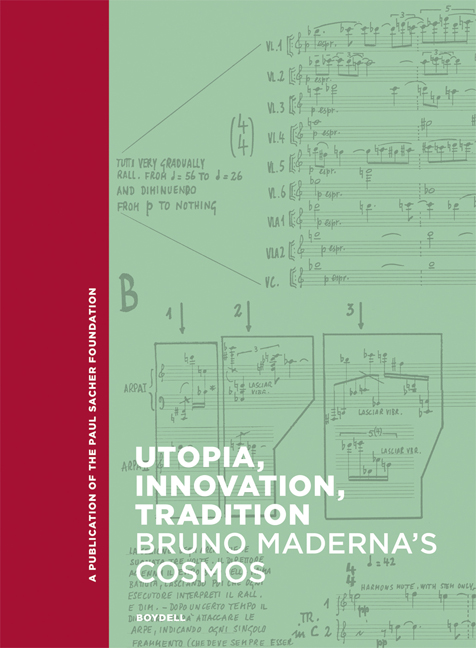Book contents
- Frontmatter
- Contents
- INTRODUCTION
- STAGING AND PERFORMING SOUNDS: A GLANCE THROUGH THE LAST THEATRICAL WORK
- BUILDING SOUNDS: THE COMPOSER
- CREATING SOUND: THE MUSIC BEYOND/WITHOUT THE STAGE
- REINVENTING SOUNDS: DIALOGUES WITH MUSIC OF EVERY EPOCH AND STYLE
- ACROSS BORDERS: THE CONDUCTOR AND THE INTERPRETER
- SEARCHING FOR ROOTS: THE DEVELOPMENT OF A STYLE
- STAGING AND PERFORMING TEXTS: A GLANCE THROUGH EARLY DRAMATURGICAL AND VOCAL WORKS
- Chronology Of Bruno Maderna’s Works
- Selected Bibliography
- Index
Space in Maderna’s Last Orchestral Works
Published online by Cambridge University Press: 17 January 2024
- Frontmatter
- Contents
- INTRODUCTION
- STAGING AND PERFORMING SOUNDS: A GLANCE THROUGH THE LAST THEATRICAL WORK
- BUILDING SOUNDS: THE COMPOSER
- CREATING SOUND: THE MUSIC BEYOND/WITHOUT THE STAGE
- REINVENTING SOUNDS: DIALOGUES WITH MUSIC OF EVERY EPOCH AND STYLE
- ACROSS BORDERS: THE CONDUCTOR AND THE INTERPRETER
- SEARCHING FOR ROOTS: THE DEVELOPMENT OF A STYLE
- STAGING AND PERFORMING TEXTS: A GLANCE THROUGH EARLY DRAMATURGICAL AND VOCAL WORKS
- Chronology Of Bruno Maderna’s Works
- Selected Bibliography
- Index
Summary
My work of composing comes to an end with rehearsals.
Bruno MadernaThis essay starts from the assumption that Maderna's last creative period was characterized by his reflection on space. This aspect is particularly evident in the orchestral compositions Quadrivium (1969), Grande Aulodia (1970), Ausstrahlung (1971), Aura (1972), and Biogramma (1972). In an attempt to provide an efficient means of addressing its vast field of application and also to do justice to the complexity of the underlying compositional thought, the concept will be divided into five main paradigms. The first is Frontality which examines the different positions of the musicians on stage; next we have Projectivity, in which these same positions are analyzed as a central compositional element that can organize the form, the development of the musical material, and its perspective; the latter is in turn analyzed in terms of its Extemporaneousness and in a context of Ambiguity; the final paradigm is Reactivity, the acoustic reaction of the orchestral space to the presence of a main melodic line.
Frontality
All the aforementioned works are similar in the fact that the orchestral layout is conceived within the orchestral structure itself, that is, on stage, without the audience being considered a physical element therein. This also applies to Quadrivium, which has often been misinterpreted in this sense. In fact, at first glance, the position of the instruments as they appear in its score might induce us to envisage a hypothetical rearrangement of the four instrumental groups in the four corners of the hall, around the audience (→ EX. 1).
However, not only does this hypothesis lack confirmation in the available sources, but a number of valid reasons point to another interpretation. First of all, although the position of the conductor is not specified in the layout in the printed score, making the idea of the dislocation of the groups quite appealing, albeit not easy to control musically, the very indication written in Italian, “Strumenti e loro disposizione in orchestra” (instruments and their layout in orchestra), leaves little room for doubt (where in is to be understood as in the orchestra space
- Type
- Chapter
- Information
- Utopia, Innovation, TraditionBruno Maderna's Cosmos, pp. 87 - 114Publisher: Boydell & BrewerPrint publication year: 2023

